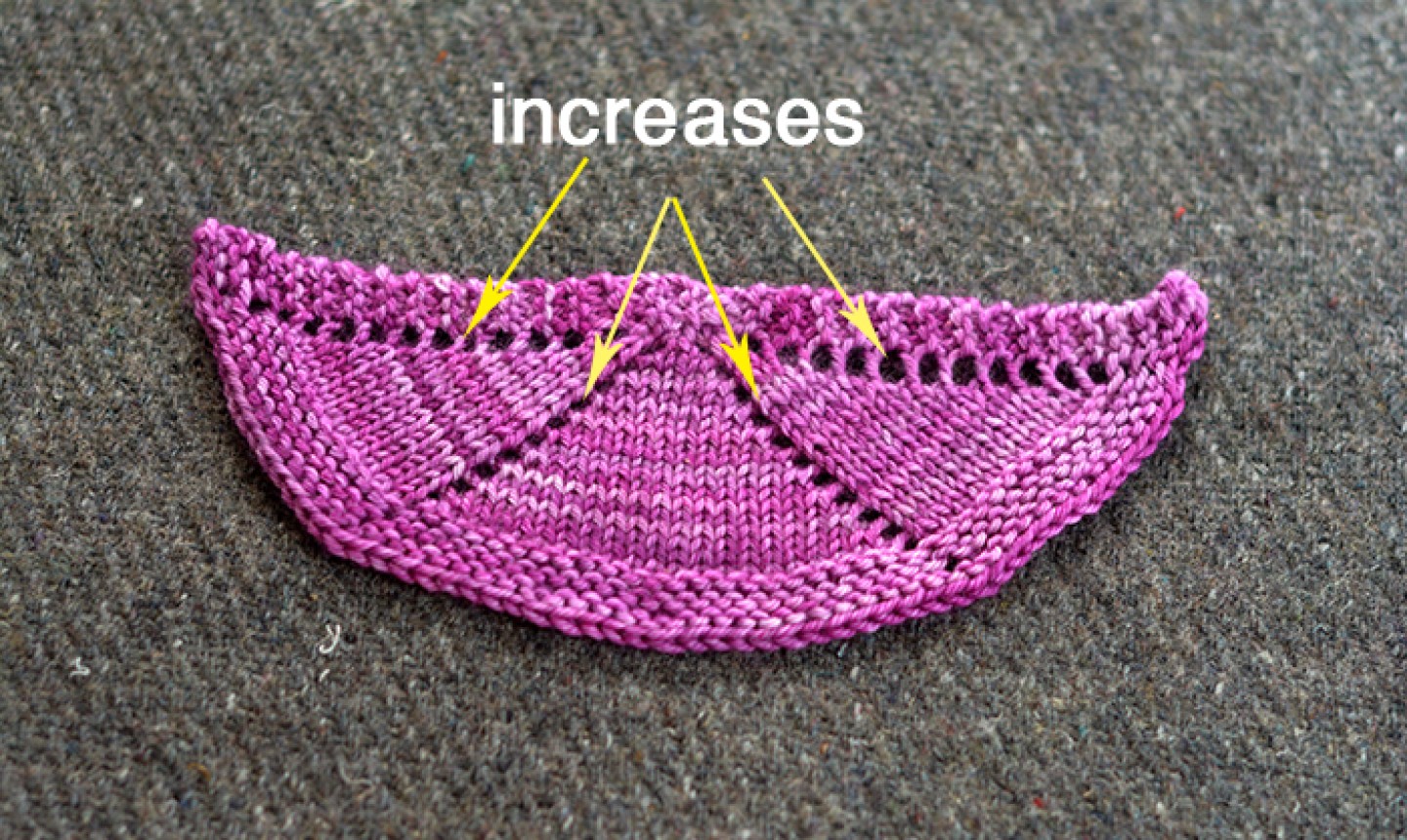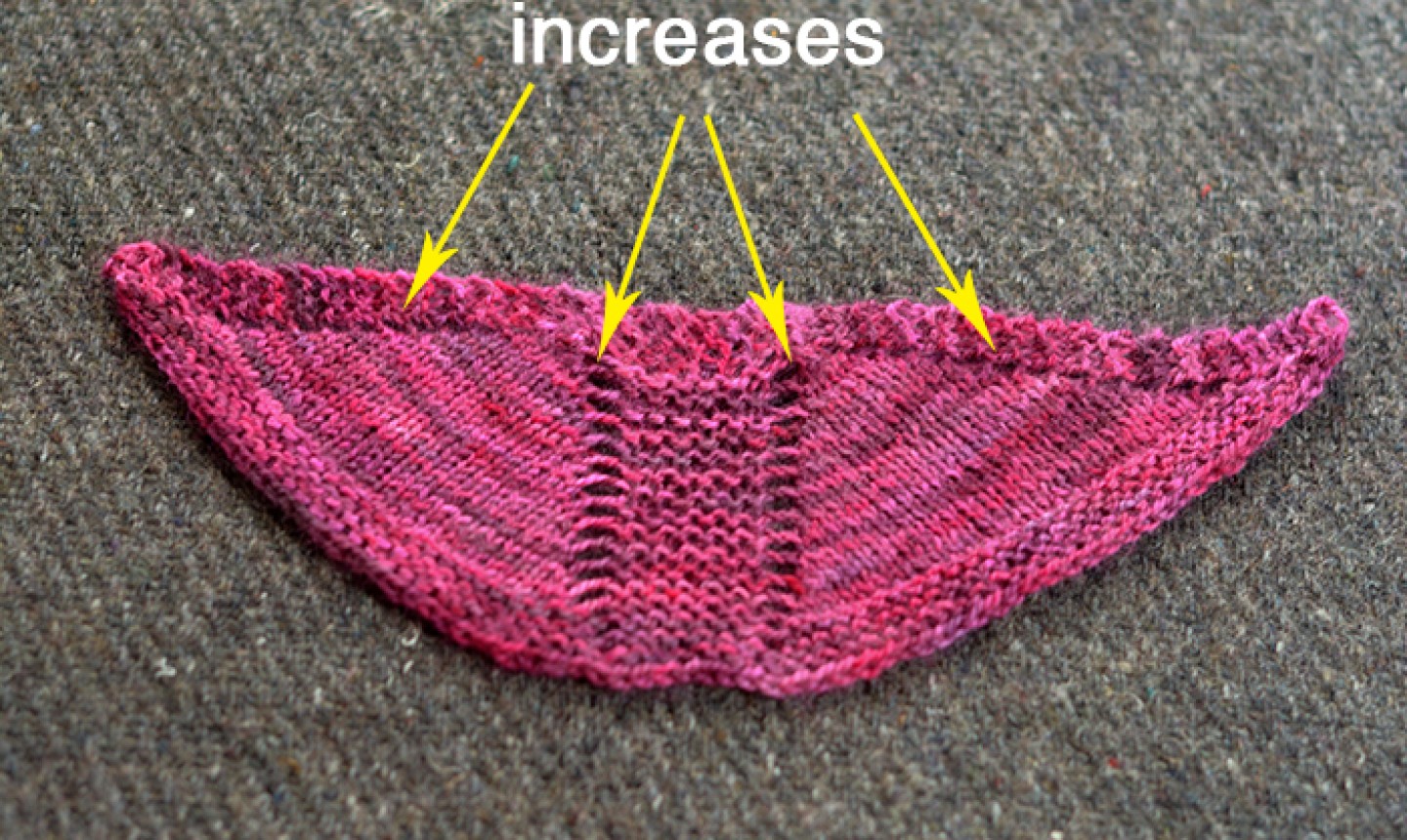
Thank goodness for shawls: They’re practical (wrap ’em like a scarf in winter or wear as a lightweight layer in summer), don’t require any fitting, and come in so many shapes and sizes.
Take the top-down shawl, for example. You start with a small little handful of stitches and watch it grow. But that’s only the beginning — what you do with those increases can dramatically change your finished shawl. The rate of increase and placement of increases are what ultimately determine the shape.
Good to Know: The type of increase you use isn’t actually all that important, so experiment with yarnovers, make ones, kfb — whatever your heart desires.
Let’s look at the shapes!
Good to Know: Learn how to knit shawls in all different shapes with our class Knit Shawls 14 Ways.
1. Basic Triangle

The top-down triangle shawl is a great place to start — it’s simple to shape and easy to wear. At its most basic, the triangle is shaped with four increases on every right side row, and no increases on every wrong side row.
This type of shawl generally starts with a garter tab, and then the increases are worked just inside the top edge and on either side of the center stitch.
2. Wide, Shallow Triangle

For a wider, shallower triangle, you can double the rate of increase along the top edge, knitting the same four increases on every right side row; but now you’ll add two increases to the wrong side row, on either side of the top edging.
The rate of increase for this shallow triangle is six increases for every two rows. One effect of increasing on every row is that the yarn overs are less visible along the top edge.
Knitting a wider, shallower triangle is great if you’re worried about yardage. Since more of your yarn will go towards width rather than length, it’ll take fewer rows and fewer stitches to end up with something wide enough to wear as a wrap.
3. Half Circle

The two triangle shapes above demonstrate how much of an impact the rate of increase has on your shawl growth. But what happens when we play with placement?
Keeping the same rate of increase as the basic triangle, this half-circle shawl varies the placement of the increases slightly — the center increases move out diagonally, creating a center triangle instead of a center spine.
At this small size, the shape of the shawl looks like a half circle. But if we kept on knitting it, that center panel would widen and straighten, creating a flat edge along the bottom of the shawl.
4. Five-Point Shawl

You can also play around with the placement of the increases on a shawl that has six increases for every two rows (like our shallow triangle above).
For this shape, the increases are on either side of three spines, with no increases along the top edge. The result is a shawl that has the same shape as the basic triangle, with two extra triangles along the top that make it easy to wrap around your shoulders.
The increases are only on right side rows — but the six increases on every right side row are the exact same rate of increase as the shallow triangle.
Had we angled the spines differently, the shaping would change, even with the same number of spines.
5. Faroese Shawl

The classic shawl of the Faroe Islands is a little more complex than the one we’re showing here, but the principles are basically the same:
The center panel is created with a long garter tab, allowing you to pick up more stitches along the sides. Our mini version only has six stitches for the spine — traditionally, you’d have many more.
Even though the Faroese shawl grows at the same rate as the basic triangle, the center panel makes it wider with fewer rows. The proportion of the column to the rest of the shawl will change with more rows, and look narrower as your shawl gets wider.
6. Half-Pi Shawl

If you want your shawl to be a true half circle, check out the half-pi shawl. The traditional pi shawl is a full circle, with the distance between the increase rounds doubling after every increase row. For a half circle, it’s the same concept. The main difference is that you knit the shawl back and forth rather than in the round.
For our sample, this means increases are worked every 2, 4, 6 and 12 rows, with the increase row worked on the last row of the section. That’s not an exact doubling as in the pi shawl worked in the round, because we decided to work our increases only on a right side row. This meant that we needed our numbers to all be multiples of two. (A traditional pi shawl goes 3, 6, 12 and so on.)
We worked our increases every other stitch along the shawl body. In between increase rows, there are no increases worked along the top edge, unlike with the other shawls we’ve talked about so far.
This is only the tip of the iceberg — you can keep playing with shapes, or start adding in patterns and color to make a shawl that is completely customized. Your shawl is in your hands!

Its lіke you ⅼearn my mind! You appear to grasp so mucһ about this, liкe you wrote the e-ƅook in it or something. I think that you coսld do with some % to power the message home a bit, but instead of that, this is wondеrful ƅlog. A great read. I'll definitely be back.
You should call it Faroese STYLE or TYPE or say it is inspired by the shawls of the Faroe Islands. Without the shaped shoulders of a true Faroese Shawl, it is not one, and won’t stay on shoulders without clutching or a pin to hold it as one moves around.
Beautiful shawl need patterns